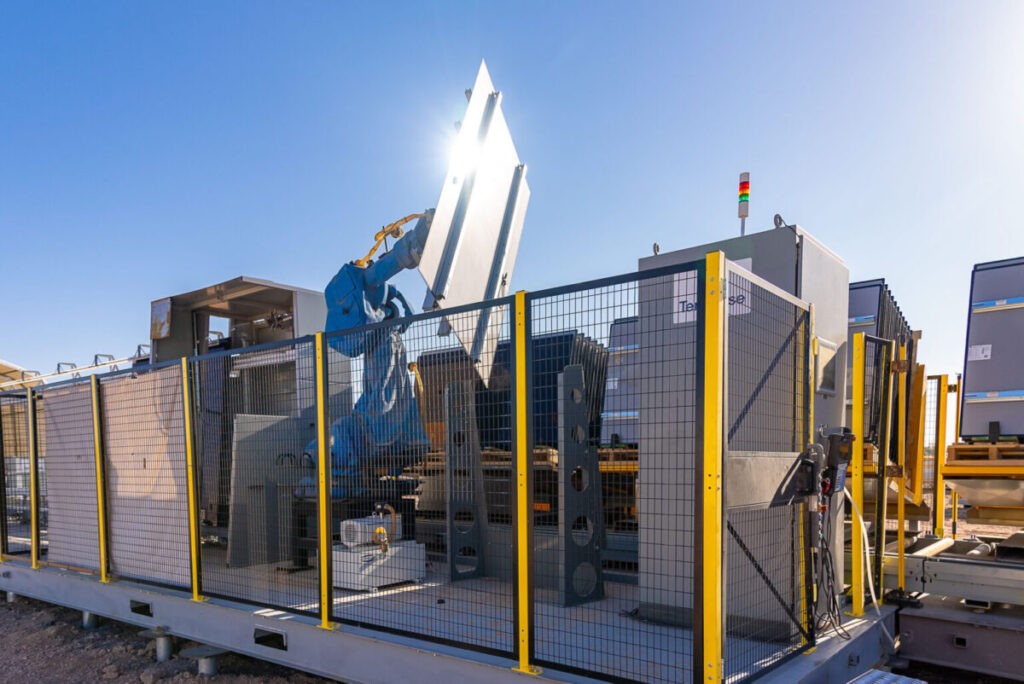The future of the design of the solar module will be heavier, not lighter. With hail and extreme weather conditions that increase, it is expected that module manufacturers will move to thicker glass to improve the impact resistance and long-term sustainability. This will considerably improve their ability to withstand high energy impact and wind waste. Although this design shift improves the chances of survival of the system, it is also a crucial challenge: heavier modules require a new approach to the installation.
Today’s large modules already weigh ~ 70 pounds, so that the boundaries of what human installers can safely process. Osha guidelines and niosh lift models emphasize the risks: wearing heavy objects several times a day, above knuckle height, away from the body (especially above the head), drastically increases the risk of musculoskeletal injuries. Imagine a team of employees who lift 100+ pounds. Modules of crates, they walk in rows of solar arroys and mount hundreds of times a day on fixed tilt or trackers systems (especially with moderate quantities of wind), it is not just an efficiency challenge, it is a safety crisis in the workplace.
The case for robotics in installation of solar module
Reducing the module size is also not a feasible solution for the weight problem. The grand promise of a smaller number of modules per megawatt has a lower racking and structural costs and improved installation efficiency. These electric savings in combination with the arrival of the 210 mm wafer have in turn-driven module designs and their volumes to the scale that is being seen today. Reverse course and making modules smaller would increase the number of units per project, which leads to more electrical and mechanical connections, which in turn increases installation companies, material costs and long -term reliability risks. Large Format modules will persist because their electricity cost benefits outweigh the challenges of dealing with them. The only logical path is to remove human labor from the lifting comparison.
This need for automation is reinforced by a serious labor shortage on a major solar market, whereby the availability of the workforce is already limited. Solar installers are a lot of demand, but short supply, and as the industry scales insatiable, the gap between the availability of the workforce and the project needs will only increase. Instead of forcing employees to repetitive, injury -sensitive tasks, robotics can enable trained workers to deal with roles with a higher value, such as project management, system companies and electrical installation. This shift not only protects employees, but also creates opportunities for career growth in an industry that is ready for long -term expansion.
The hidden costs of manual labor: Workman’s Comp And Budget Offsets
Budgets for the construction of solar energy are not only taken into account with workers’ wage, they also include the compensation insurance of the workman, injury liability and lost time due to work-related injury. As the module vaults increase, the frequency of voltage injuries, back issues and repetitive movement disorders will inevitably increase, thereby increasing the compensation claims of the workman and increasing the insurance costs. For developers and EPCs, these are costs that are absorbed across the board and exert downward pressure on the viability of the project.
If it remains not addressed, this increase in the risk is not just a safety problem, it is a financial problem. Over time, the added insurance taxes of increased injuries will compensate or even higher than the costs of accepting robotics for module installation. By proactively integrating automation, companies can reduce liability in the long term and reduce that budget compensation to project investments with a higher value instead of preventing injury costs. Robotics not only compensates for financial headwind in connection with these risks, but also reduce the fracture rates of module, lower QC and O&M inspection costs (on -site technologies) and minimizing downtime by wind. At the same time, they improve the safety of employees considerably.
Robotics: the following evolution in Module installation
Companies such as Luminous Robotics, AES Corporation, Sarcos Technology, ULC Technologies and Visping are taking on this challenge by automating individual modula manipulation and installation. These robot solutions remove human lifting restrictions, make the use of thicker glass and stronger frames possible, speeds up implementation and improving precision, ensuring that modules are mounted correctly and reducing risks for incorrect alignment.
As the use of robot module Mainstream becomes, the industry no longer has to design modules for human hefimites. Instead, we can give priority to sustainability and reliability, so that panels are optimized for automation instead of manual labor.
Total System Predassembly: the next border
In addition to module handling, terabase energy, 5b, planted solar and load robotics are a revolution brought about in the implementation of solar energy by factory-based preassembly and robot-like on-site construction. Charge Robotics automates the mounting of module, streamlining the installation at Rhine level. Terabase Energy develops solutions for robot -like tanning field to eliminate manual labor in large -scale installations. 5Bs prefabricated solar panels come almost completely assembled on site, reducing field work by a maximum of 80%. Planted solar -son integrated an automation throughout the entire construction process of the solar energy plant.
By praising large parts of solar arroys in controlled environments or utilizing field robotics for installation, these companies reform how solar farms are built.
Why the solar industry now has to embrace robotics
With the increasing module sizes, the shortages of labor compounds and escalating safety risks in the workplace, automation is no longer a luxury – it is a necessity.
As robotics are more integrated into the installation of solar module and system implementation, we will probably see a bifurcation in module design:
One path will optimize modules for automated installation, making larger, heavier and more sustainable designs that can be able to handle robots efficiently. The others will focus on modules for human installation, which remain smaller and lighter for projects such as residential, commercial and carports.
By accelerating the robot -like commitment today, industry can pass its dependence on human disabilities, improve the sustainability of the module and save costs through automation – throughing in the next evolution of solar energy.
Frank Oudheusden and Chris Needham is at Azimuth Advisory Services. Follow up LinkedIn.
The views and opinions expressed in this article are the author, and do not necessarily reflect it by PV -Magazine.
This content is protected by copyright and may not be reused. If you want to work with us and reuse part of our content, please contact: editors@pv-magazine.com.
Popular content


